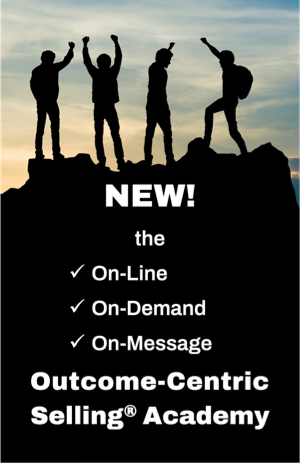Sales Leaders: Stop Optimising for Activity and Start Optimising for Outcomes
November 17, 2025

Far too many sales organisations are still measuring what's easy to measure, rather than what actually matters. Call volumes, email touches, meeting counts, pipeline coverage ratios – these activity metrics dominate sales dashboards and CRM reports across many organisations and industries.
But here's the uncomfortable truth: none of these metrics predict whether your customer will achieve their desired outcomes.
And here's why this is so important: if your customer doesn't achieve their critical business outcomes, your renewal rates will suffer, your expansion opportunities will vanish, and your reputation in the market will erode. In complex B2B sales, activity-based metrics create the illusion of progress whilst obscuring the reality of value creation.
The Activity Trap
The over-emphasis on activity metrics stems from a fundamental misunderstanding of what drives success in modern B2B selling. Sales leaders inherited a management philosophy from an era when volume and velocity mattered most – when products were simpler, buying cycles were shorter, and customer relationships were transactional.
In that environment, the law of large numbers worked. Make enough calls, send enough emails, book enough meetings, and deals would materialise. But complex B2B sales operates under entirely different dynamics. Here, success depends not on the quantity of interactions but on the quality of insights shared, the depth of relationships built, and the precision with which you align your solution to measurable business outcomes.
When sales teams are incentivised primarily on activity, several predictable issues emerge:
- Salespeople prioritise speed over understanding, rushing through discovery to hit their activity targets
- Generic value propositions replace customer-specific outcome narratives
- Qualification becomes superficial, leading to bloated pipelines filled with opportunities that were never winnable
- Sales conversations focus on product features rather than business transformation
- Customer success is at best an afterthought rather than the foundation of the relationship
What We Should Be Measuring Instead
The alternative to activity-based management is not to abandon measurement altogether. Rather, it's to reorient our metrics around the outcomes that actually matter – both for our customers and for our own organisations.
For customers, this means measuring whether they are making meaningful progress towards the business objectives that motivated them to engage with us in the first place. Are their operational metrics improving? Are they achieving the financial returns they anticipated? Are they realising the strategic advantages we promised?
For our own organisations, this means measuring the quality and health of our opportunities, not just their quantity. A robust outcome-centric measurement framework might include:
Opportunity Quality Metrics:
- ICP alignment scores – how closely do your active opportunities match your ideal customer profile?
- MEDDPICC+ completion rates – what percentage of opportunities have all qualification criteria thoroughly addressed?
- Champion strength assessments – have you developed and nurtured genuine champions with the capability and willingness to drive internal change?
- Competitive differentiation clarity – can your salespeople (and your “champions”) articulate why you're uniquely positioned to deliver the customer's desired outcomes?
Customer Outcome Metrics:
- Adoption and utilisation rates – are your customers actually using what they bought?
- Realised value versus expected value – are your customers consistently achieving the outcomes you promised?
- Net retention rates – are your customers renewing and expanding their relationship with you?
- Customer advocacy scores – would customers actively recommend you to their peers?
Sales Capability Metrics:
- Discovery conversation quality – are your salespeople uncovering their customer's critical business issues?
- Value proposition relevance – are you tailoring your messaging to each customer's specific context?
- Forecast accuracy – can you actually confidently predict not just whether deals will close, but when and why?
- Win rate by opportunity type – where do you win consistently, and where do you struggle?
A Cultural Shift is Required
Moving from activity-based to outcome-based metrics requires more than new dashboards. It demands a fundamental shift in sales culture – from compliance to capability, from process rigidity to strategic thinking, from short-term quota achievement to long-term value creation.
This shift begins with how we recruit. Instead of prioritising candidates who excel at high-volume prospecting, we need to seek out salespeople who are naturally curious, comfortable with complexity, and capable of strategic business conversations with senior executives.
It continues with how we train. Rather than teaching product features and objection-handling scripts, we need to develop skills in business diagnosis, outcome articulation, value quantification, and consensus-building amongst diverse stakeholder groups.
And it culminates in how we coach. Sales managers must evolve from being pipeline inspectors to being strategic advisors – helping their teams navigate complex buying dynamics, refine their qualification judgement, and strengthen their customer outcome narratives.
The Role of AI in Outcome-Centric Selling
Artificial intelligence offers significant potential to accelerate this transition. Properly applied, AI can help sales teams move beyond activity tracking to outcome prediction and guidance.
AI-powered tools can analyse patterns across thousands of opportunities to identify which early indicators most reliably predict success. They can assess the strength of qualification across multiple dimensions simultaneously. They can flag risks before they become crises and suggest situationally appropriate tactics based on what has worked in similar contexts.
But AI cannot replace the fundamentally human work of understanding a customer's business context, building trust with stakeholders, navigating organisational politics, and co-creating solutions that deliver measurable value. Technology should augment human judgement, not substitute for it.
Making the Transition
For sales leaders who recognise that their organisation needs to make this transition, I would suggest the following approach:
- First, audit your current metrics. What are you actually measuring and incentivising? How much of your management attention focuses on activities versus outcomes? Be honest about the gaps.
- Second, be crystal-clear what "good" looks like. What constitutes a well-qualified opportunity in your environment? What customer outcomes are you uniquely positioned to deliver? What capabilities do your best salespeople demonstrate that others lack?
- Third, redesign your measurement framework to emphasise these outcome-oriented indicators. Reduce the prominence of activity metrics whilst elevating quality and outcome metrics.
- Fourth, invest in the training and coaching required to develop these capabilities across your sales team. This is not a quick fix – building strategic selling capabilities takes time and sustained effort.
- Finally, make sure that your incentive schemes are aligned with your new priorities. If you continue to compensate salespeople primarily for short-term revenue generation without regard for customer outcomes, you will perpetuate the very behaviours you're trying to change.
Conclusion: Activity is no Substitute for Strategy
The pressure to demonstrate productivity leads many sales organisations to over-index on activity metrics. But activity without strategic purpose is simply busy work (or “busy foolishness”).
In complex B2B sales, success comes not from maximising the volume of interactions but from maximising the value of outcomes – for customers and for your own organisation. Sales leaders who make this transition will build more resilient businesses, develop more capable teams, and create more satisfied customers.
Because in the end, customers don't buy activity. They buy outcomes. And the sales organisations that orient everything they do around delivering those outcomes will be the ones that thrive in an increasingly competitive marketplace.
At least, that’s what I think: what about you?
By the way, these key principles underpin our recently updated “Outcome-Centric Selling® Academy". You can find out more (and sign up for a free trial) here.


Comments